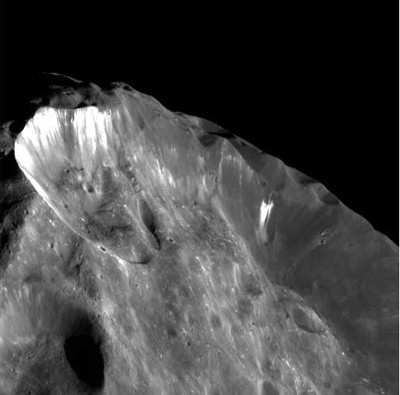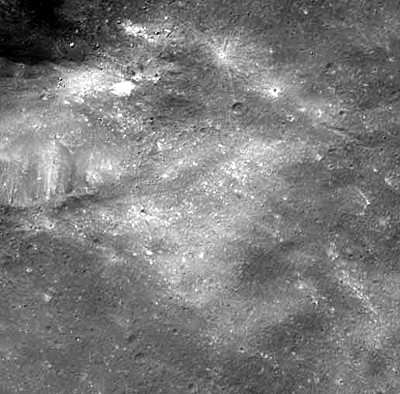Scientists Debate Origins Of Saturnian Moon
Images collected during Cassini's close flyby of Saturn's moon,
Phoebe, have yielded strong evidence that the tiny object may
contain ice-rich material, overlain with a thin layer of darker
material perhaps 300 to 500 meters (980 to 1,600 feet) thick.

The surface of Phoebe is also heavily potholed with large and
small craters. Images reveal bright streaks in the ramparts of the
largest craters, bright rays which emanate from smaller craters,
and uninterrupted grooves across the face of the body.
"The imaging team is in hot debate at the moment on the
interpretations of our findings," said Dr. Carolyn Porco, Cassini
imaging team leader at the Space Science Institute in Boulder (CO).
"Based on our images, some of us are leaning towards the view that
has been promoted recently, that Phoebe is probably ice- rich and
may be an object originating in the outer solar system, more
related to comets and Kuiper Belt objects than to asteroids."
In ascertaining Phoebe's origin, imaging scientists are noting
important differences between the surface of Phoebe and that of
rocky asteroids which have been seen at comparable resolution.
"Asteroids seen up close, like Ida, Mathilde, and Eros, and the
small martian satellites do not have the bright 'speckling'
associated with the small craters that are seen on Phoebe," said
Dr. Peter Thomas, an imaging team member from Cornell University,
Ithaca (NY).
The landforms observed in the highest resolution images also
contain clues to the internal structure of Phoebe. Dr. Alfred
McEwen, an imaging team member from the University of Arizona,
Tucson, said, "Phoebe is a world of dramatic landforms, with
craters everywhere, landslides, and linear structures such as
grooves, ridges, and chains of pits. These are clues to the
internal properties of Phoebe, which we'll be looking at very
closely in order to understand Phoebe's origin and evolution."

"I think these images are showing us an ancient remnant of the
bodies that formed over four billion years ago in the outer reaches
of the solar system," said Dr. Torrence Johnson, an imaging team
member from NASA's Jet Propulsion Laboratory, Pasadena (CA).
"Battered and beat-up as it is, it is still giving us clues to its
origin and history."
Phoebe may be an icy interloper from the distant outer solar
system which found itself captured by giant Saturn in its earliest,
formative years. Final conclusions on Phoebe's origins await a
combination of the results on Phoebe's surface structures, mass and
composition gathered from all 11 instruments, which collected data
during the flyby on June 11, 2004.
"This has been an impressive whirlwind flyby and it's only a
curtain raiser on the events about to begin," said Porco.
Cassini arrives in orbit around Saturn on the evening of June
30, 2004.
The Cassini-Huygens mission is a cooperative project of NASA,
the European Space Agency and the Italian Space Agency. JPL, a
division of the California Institute of Technology in Pasadena,
manages the Cassini-Huygens mission for NASA's Office of Space
Science, Washington (DC). The Cassini orbiter and its two onboard
cameras were designed, developed and assembled at JPL. The imaging
team is based at the Space Science Institute, Boulder (CO).
 ANNouncement: Now Accepting Applications For Oshkosh 2024 Stringers!!!
ANNouncement: Now Accepting Applications For Oshkosh 2024 Stringers!!! Aero-News: Quote of the Day (06.13.24)
Aero-News: Quote of the Day (06.13.24) ANN's Daily Aero-Term (06.13.24): Dead Reckoning
ANN's Daily Aero-Term (06.13.24): Dead Reckoning ANN's Daily Aero-Linx (06.13.24)
ANN's Daily Aero-Linx (06.13.24) ANN FAQ: How Do I Become A News Spy?
ANN FAQ: How Do I Become A News Spy?




